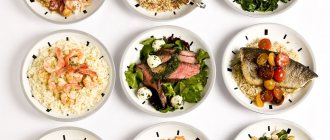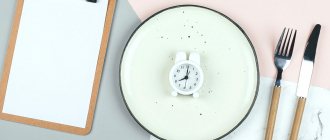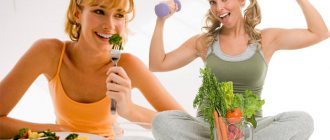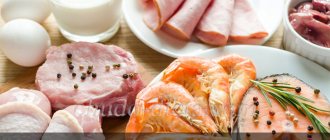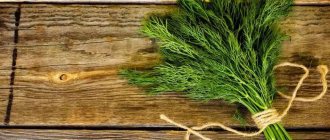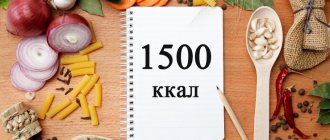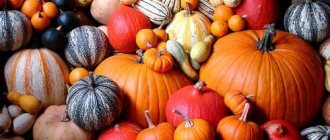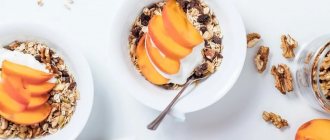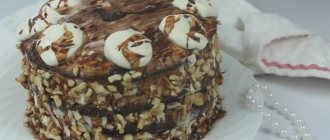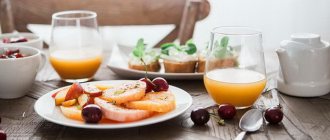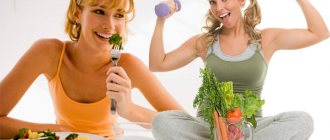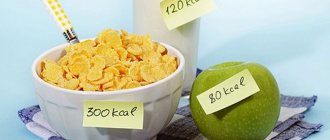Recommendations for creating a menu for 1200 kcal with BJU
When creating a menu for weight loss with 1200 kcal calories, you must adhere to the following recommendations:
- The main volume of liquid (about 80%) must be drunk before 18-00 pm to avoid swelling. The amount of water consumed during the day (taking into account the water content in food) should be about 30–35 ml/kg of body weight.
- The hours and number of meals, the intervals between them, the distribution of the energy value of the diet according to the chemical composition, the weight of meals during weight loss play an important role when creating a menu for weight loss. 4-5 meals a day are recommended, the gap between main meals should be no more than 4-5 hours. It is necessary to include 2 snacks between breakfast and lunch, and lunch and dinner. Before going to bed, no later than 1.5–2 hours before bedtime, you can include low-calorie foods in your diet: milk or fermented milk products.
- When correcting weight, you need to pay attention to the amount of protein. The ideal protein ratio for weight loss is considered to be 1.5–2 grams per your ideal weight. It is not recommended to consume more than 2 grams of protein per day! You can read how to correctly calculate KBZHU for weight loss here.
- It is necessary to control the amount of carbohydrates taken from food and choose the right foods that contain them. It is extremely important to exclude simple carbohydrates from your weight loss menu as much as possible! Simple carbohydrates include: sugar, confectionery, honey, jam, baked goods, loaves, packaged juices and carbonated drinks, premium flour, semolina, white wheat pasta, some sweet types of fruits and vegetables. An increased amount of refined carbohydrates in the diet contributes to increased cholesterol in the blood, the development of atherosclerosis, obesity, diabetes, and cholelithiasis.
- When creating a 1200 kcal menu for weight loss, you must include dietary fiber in your diet. The role of dietary fiber is reduced to reducing the energy value of food, stimulating bile secretion processes, increasing the volume of food and the period of its breakdown, reducing cholesterol levels in the blood, and normalizing the composition of intestinal microflora. The main sources of fiber are: wheat bran , beans, lentils, oatmeal, nuts, dates, rose hips, raisins, vegetables, fruits, rye bread and other healthy foods.
- Vegetables are the main source of fiber, so eating vegetables is acceptable at any time of the day.
- Fruits are only allowed to be consumed before 16:00. 3–4 servings of fruit are allowed per day (1 serving of fruit is approximately equal to 80 grams).
- Important to remember! When losing weight, food should be enjoyable, varied, nutritious and healthy!
Menu for 1500 kcal by day
In total, we offer 7 diet options for every day of the week. The first line is the general KBJU, that is, calories, proteins, fats, carbohydrates for the whole day. Then, in order, there is a detailed description of 3 main meals and 3 snacks. Each of them will indicate the products, their weight or quantity, and recipe.
Please note that coffee and tea without sugar and milk have no calorie content, so you can include them after any meal. Don't forget to drink clean water, about 1.5-2 liters daily.
Menu for 1500 kcal: day 1
Total KBJU: 1528 kcal, proteins – 110.8 g, fats – 63.2 g, carbohydrates – 126.7 g.
Breakfast: Long-cooked oat flakes – 40 g, milk – 100 ml, flower honey – 13 g, walnuts – 20 g, banana – 50 g. Cook porridge with milk from the flakes, add honey, crush the nuts and add banana slices.
Snack: Wheat slices – 2 pieces (~20 g), peanut butter – 14 g.

Lunch: Turkey fillet – 180 g, zucchini and sweet peppers – 100 g each, tomatoes – 80 g, onions – 50 g, eggplant – 70 g, butter – 5 ml, Borodino bread – 30 g. Pour vegetable oil into the bottom of the multicooker bowl . Chop the vegetables and meat, transfer them to a container, add a little water, spices and salt, and set the stew mode. If you don’t have a multicooker, you can cook in a deep frying pan.
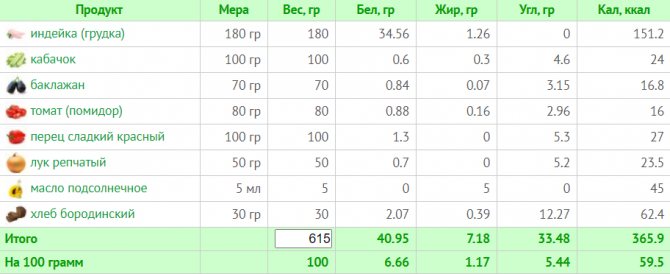
Snack: Cabbage – 100 g, carrots – 60 g, beets – 60 g, olive oil – 6 ml, lemon juice – 5 ml, Adyghe cheese – 30 g. Chop the vegetables, pour in citrus juice, mash with your hands, leave. Add oil, cut cheese.

Dinner: Eggs – 2 pieces, egg whites – 1 piece, champignons – 70 g, butter – 3 g. Fry the mushrooms with butter, break the eggs. You will get scrambled eggs with mushrooms.

Snack: Cottage cheese 2% – 120 g, sour cream 10% – 25 g, cucumber – 40 g, dill – 15 g.

Menu for 1500 kcal: day 2
Total KBJU: 1505 kcal, proteins – 124.9 g, fats – 55.4 g, carbohydrates – 128 g.
Breakfast: Cottage cheese 2% – 120 g, raw egg whites – 2 pcs., rice flour – 30 g, raisins – 10 g, pear – 50 g, flower honey – 15 g, sweetener – optional. Steam the raisins. Add whites to the cottage cheese, grind, add sweetener and flour, dried fruits. Now mix, make cheesecakes and fry or bake in the oven. Drizzle with honey and chop the pear.

Snack: Rice bread – 2 pieces (~20 g), sesame urbech – 12 g.

Lunch: Raw potatoes – 150 g, pollock – 120 g, onions – 40 g, carrots – 50 g, cucumber and bell pepper – 50 g each, olive oil – 6 ml, parsley – 8 g, sunflower oil – 6 ml. Boil the potatoes. Fry the onions and carrots, place the pollock on them, add water and simmer. Cut the salad, season with olive oil.
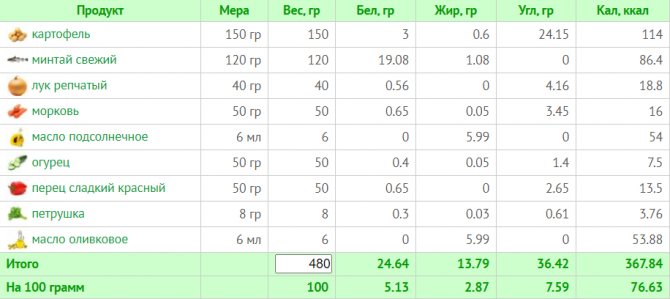
Snack: Egg – 1 piece, milk 1.5% – 70 ml, tomatoes – 25 g and hard Dutch cheese – 18 g. Beat the egg with milk in a mug, add salt. Add finely chopped tomato, grated cheese, stir. Place in the microwave.

Dinner: Chicken thigh fillet – 150 g, zucchini – 100 g and sauerkraut – 120 g, camelina oil – 3 ml. You need to stew chicken meat with zucchini.

Snack: Green beans – 200 g, boiled egg whites – 100 g and natural yogurt – 30 g. Mix the ingredients into a salad (boil the beans first).

Menu for 1500 kcal: day 3
Total KBJU: 1490 kcal, proteins – 121.8 g, fats – 50.4 g, carbohydrates – 136 g.
Breakfast: Lavash – 70 g, eggs – 2 pieces, milk 2.5% – 30 ml, tomatoes – 50 g and lettuce leaves – 15 g, refined sunflower oil – 2 ml. Grease a frying pan with oil, beat eggs with milk and salt, pour in and fry. On pita bread lettuce, tomato cubes, omelette, then roll and cut in half.

Snack: Apple – 150 g, soft cottage cheese 5% – 120 g.

Lunch: Brown rice (dry) – 40 g, cod – 180 g, cabbage – 100 g, carrots – 15 g, pumpkin – 75 g, onion – 25 g, sunflower oil – 3 g. Cook the rice, bake the cod (together with a portion of dinner). Stew the vegetables and pumpkin, take them in double portions, so that the other half is left for the evening meal.
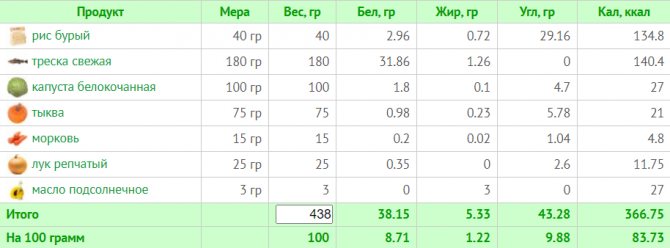
Snack: Cucumber – 100 g, tomatoes – 100 g, lettuce leaves – 25 g, pine nuts – 10 g, olives – 25 g, camelina oil – 7 ml. Chop the ingredients and make a salad.

Dinner: Cod – 210 g, cabbage – 100 g, onion – 25 g, carrots – 15 g, pumpkin – 75 g, sunflower oil – 3 g. Fish and stewed vegetables according to the lunch recipe.

Snack: Kefir 1% fat – 250 ml.
Menu for 1500 kcal: day 4
Total KBJU: 1487 kcal, proteins – 116.4 g, fats – 55.2 g, carbohydrates – 126 g.
Breakfast: Egg – 1 piece, yeast-free bread – 50 g, lightly salted trout – 50 g, lettuce – 20 g, cherry tomatoes – 100 g, butter – 10 g. Fry the egg in a frying pan, make sandwiches (bread, fish and butter ), add vegetables.

Snack: Fruits, namely tangerine – 150 g, kiwi – 70 g, green apple – 130 g.

Lunch: Dry buckwheat – 40 g, chicken liver – 120 g and sour cream 10% – 20 g, lettuce – 20 g, sauerkraut – 120 g, olive oil – 7 ml. Pour boiling water into the cereal for 40-50 minutes, simmer the liver in sour cream and water. Place on a plate lined with lettuce leaves, then add the cabbage and butter.

Snack: Ryazhenka with 4% fat content – 250 ml, dried apricots – 3 pieces (~20 g).

Dinner: Mixed vegetables (frozen or fresh) – 200 g and chicken fillet – 130 grams. Cook a light soup in broth with finely chopped meat, or you can simply simmer the ingredients together in a frying pan.

Snack: Boiled egg whites - 4 pieces, sour cream 10% - 30 g, cucumber - 100 g. Make large cuts from the whites and cucumber, then season the salad with sour cream.

Menu for 1500 kcal: day 5
Total KBJU: 1533 kcal, proteins – 96.7 g, fats – 57.5 g, carbohydrates – 157.4 g.
Breakfast: Dry buckwheat – 35 g, milk – 180 ml and grain bread – 1 layer (~20 g), avocado – 40 g, curd cheese – 12 g. Boil the cereal. Add salt and pour milk. Spread the bread with cheese and place avocado slices on top.

Snack: Pear – 80 g, banana – 80 g, apple – 90 g, sour cream 10% – 30 g. Cut the fruit into cubes, season with sour cream. Get a fruit salad.

Lunch: Dried lentils – 60 g, champignons – 120 g, tomatoes – 100 g, onions – 25 g, zucchini – 75 g, bell pepper – 50 g, sunflower oil – 5 ml. First, boil the lentils until fully cooked. Chop the vegetables and mushrooms, fry, add the lentils that have been drained of water, add salt and spices, then stir. Cover with a lid and leave the dish for another 5-7 minutes.
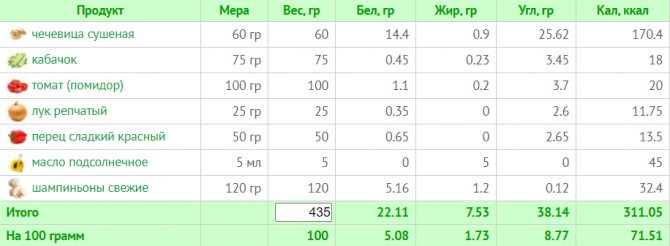
Snack: Lavash – 60 g, cucumber – 50 g, tuna in its own juice – 55 g. Place the chopped cucumbers with fish on strips of pita bread, roll into rolls.

Dinner: Chicken eggs - 3 pieces, green beans, broccoli - 100 g each, melted butter - 4 g. Prepare classic scrambled eggs from the ingredients.

Snack: Seaweed - 100 g, corn - 20 g, shrimp - 70 g. Boil the seafood until done, then mix everything into a salad, add salt.

Menu for 1500 kcal: day 6
Total KBJU: 1539 kcal, proteins – 117.1 g, fats – 58.5 g, carbohydrates – 132 g.
Breakfast: Cottage cheese 5% - 100 g, milk 2.5% - 150 ml, orange juice - 100 ml, banana - 60 g and flower honey - 10 g. Squeeze citrus juice into a blender, and then add chopped banana, honey, beat cottage cheese and milk until smooth.

Snack: Borodino bread – 2 pieces (~60 g), lettuce leaves – 18 g, tomatoes, cucumbers – 50 g each, chicken fillet – 80 g. Boil or bake the meat. Then make sandwiches: put lettuce, vegetables in layers and sliced chicken on bread.

Lunch: Whole grain pasta (dry) – 50 g, minced beef – 100 g, tomato paste – 20 g, cauliflower – 70 g. Fry the meat and add the pasta with water, simmer, add the boiled pasta, stir. Boil cauliflower (fresh or frozen) separately or steam it.

Snack: Kefir 1.5% – 150 ml, hazelnuts – 4 pieces (~14 g).

Dinner: Tuna in its own juice – 90 g, arugula – 40 g, cucumber – 100 g, egg – 1 piece (boiled), olive oil – 5 ml. Make a light salad.

Snack: Greek yogurt 2% – 100 g, strawberries – 100 g (or other berries).

Menu for 1500 kcal: day 7
Total KBJU: 1496 kcal, proteins – 93.3 g, fats – 70.5 g, carbohydrates – 122.4 g.
Breakfast: Rice cakes – 2 pieces (~20 g), avocado – 80 g, egg – 1 piece, lemon juice – 5 ml, dark chocolate – 15 g, coffee – 200 ml. Mash the avocado and pour in citrus juice, salt, and spread on the bread. Boil the eggs and serve together.
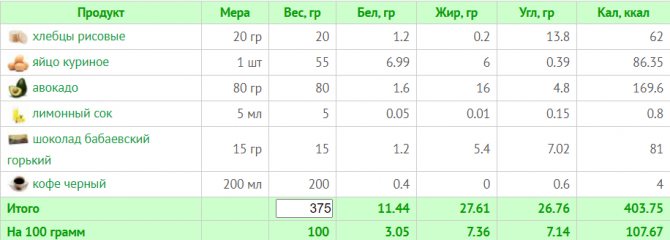
Snack: Chia seeds – 25 g, oat milk – 120 ml, kiwi – 40 g. Pour milk over chia 3 hours before. Slice the kiwi. Place everything in a glass in layers.

Lunch: Spinach – 150 g, low-fat cream 10% – 100 ml, fresh pink salmon – 150 g, broccoli – 100 g, sour cream 10% – 30 g, buckwheat – 30 g. Chop the spinach, add to the cream, bring to a boil, remove , beat with a blender, add salt (cream soup). Pour water into buckwheat and boil. Bake fish with broccoli in sour cream sauce.

Snack: Green apple – 150 g, Maasdam cheese – 22 g.

Dinner: Chicken – 75 g, broccoli and cauliflower – 35 g each and onion – 20 g, egg white – 1 pc., corn starch – 0.25 tbsp. l., milk – 25 ml. Chop the vegetables and meat, put them in a blender, add starch, and puree them. Beat the egg whites with salt until stiff, fold into the mixture, and pour into silicone molds. Now put in the oven for 20 minutes at 180 degrees. You will get chicken soufflé.
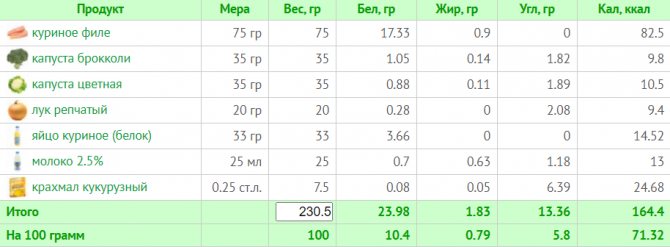
Snack: Peeled grapefruit – 200 g.
Sample menu for 1200 kcal for weight loss
When drawing up a menu for losing weight by 1200 kcal, you need to take into account your height, age, ideal weight, your metabolism, daily calorie needs, physical activity rate, energy consumption and other indicators. Based on these data, we calculate BJU norms for a calorie diet of 1200 kcal.
An approximate menu of proper nutrition for 1200 kcal for weight loss could be as follows:
The calorie content of the diet is 1231 kcal. BJU ratio: proteins – 69 g, fats – 54.5 g, carbohydrates – 116.7 g.
Breakfast 363.1 KCAL BJU 22.9 / 23.8 / 14
In the fight against extra pounds, you should not underestimate such a meal as breakfast. It is breakfast that determines whether you will be full during the day or hungry, active or lethargic. Breakfast should make up about 25–30% of your daily caloric intake. It should include complex carbohydrates and proteins, and be tasty and healthy!
- The ideal time for breakfast is from 07-00 to 09-00 am. To actively remove toxins from the body, you need to drink 1-2 glasses of water at room temperature on an empty stomach.
- Recommended breakfast dishes: porridge, scrambled eggs, scrambled eggs, healthy homemade shawarma, cheesecakes, pancakes, baked apples, vegetable salads, diet sandwiches, low-fat cheeses, cottage cheese with a fat content of up to 5%.
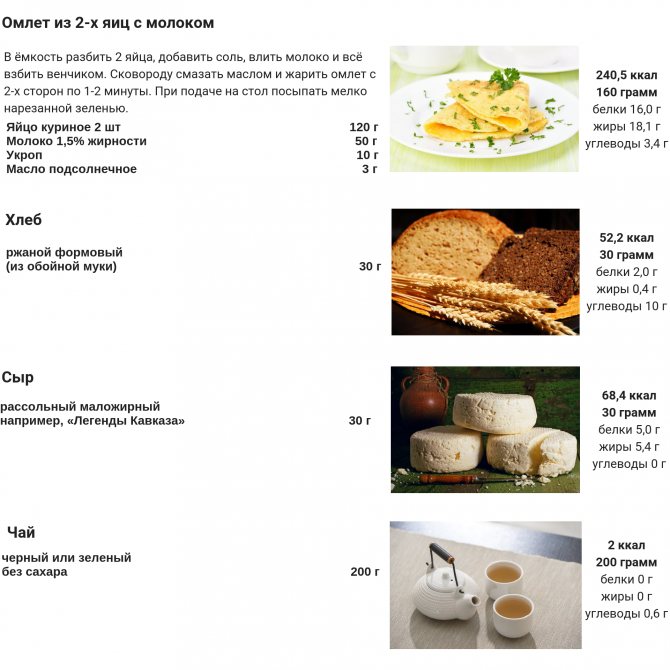
Breakfast for a 1200 kcal menu
Snack 149.2 KCAL BJU 2.5 / 7.9 / 16.0
A snack with five meals a day should be 10-15% of the daily calorie intake. Typically, the first snack should be included between breakfast and lunch and should include fruits, nuts, sweet salads, smoothies, dried fruits, bread, cheese, proper snacks or proper diet baked goods.
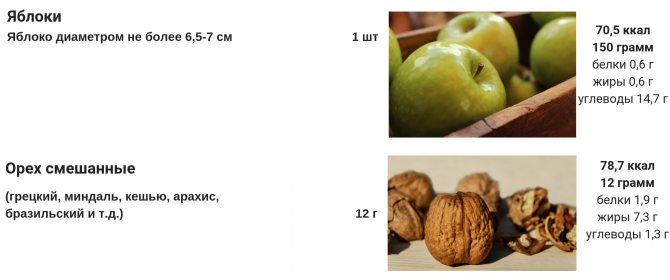
Snack for a 1200 kcal menu
Lunch 331.9 KCAL BJU 16.9 / 9.9 / 44.2
Lunch is the basis of proper nutrition for weight loss. Lunch with proper nutrition should be nutritious and balanced. With five meals a day, it should be about 35% of the daily calorie intake and include soups, borscht, cabbage soup in chicken and beef broth, porridge, whole grain or rye bread, protein foods, salads, and dietary desserts.
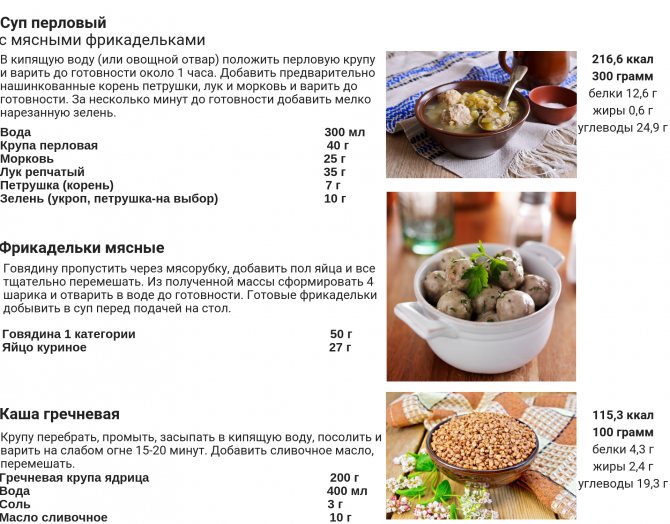
Lunch for a 1200 kcal menu
Afternoon snack 147.4 KCAL BJU 4.3 / 5.2 / 22.0
An afternoon snack with five meals a day should be 10-15% of the daily calorie intake. Typically, an afternoon snack with proper nutrition for weight loss should include vegetable salads, cottage cheese with sour cream, fermented milk products, and cottage cheese desserts.
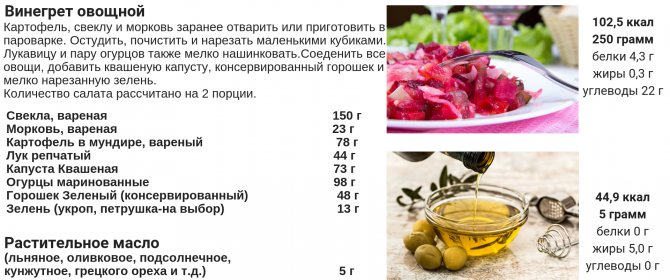
Afternoon snack for menu 1200 kcal
Dinner 239.2 kcal BJU 22.4 / 7.7 / 20.5
For dinner, with five meals a day, you need to leave about 20% of the daily ration. With proper nutrition for weight loss, dinner should include low-fat protein dishes with vegetables, vegetable salads, cheese, eggs, dairy products or milk.
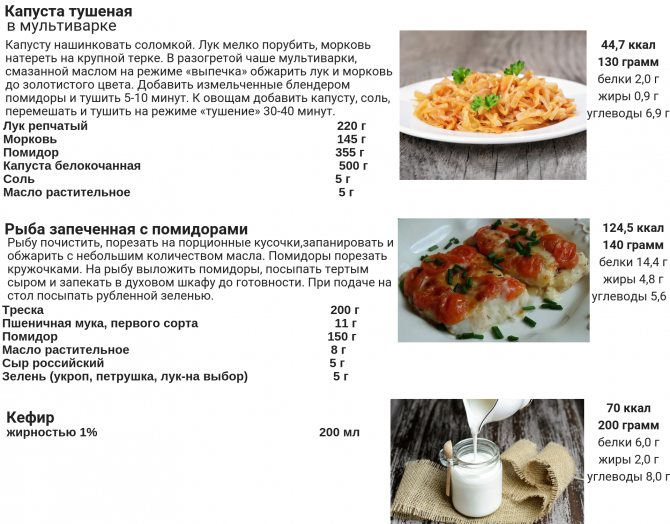
Dinner menu 1200 kcal
Proper nutrition for weight loss: what is possible and what is not?
How to replace foods on a weight loss menu for a week? We have put together a fairly simple dietary menu. But if necessary, change products to those that you like best/have on hand. It's simple - replace lean protein with lean protein: chicken, fish and seafood, eggs, cottage cheese. Complex carbohydrates (which can be exchanged for each other): buckwheat, brown rice (there is no brown rice - take what you have), durum wheat pasta (in extreme cases, regular wheat can also be used), beans and lentils. Raw vegetables without restrictions - they have very few calories. For example, if your stomach growls in the evening and you can’t fall asleep, take a cucumber or tomato. Fill your stomach and it's no more than 50-100 calories.
For your “first acquaintance” with proper nutrition for weight loss, you don’t have to painstakingly count calories and nutritional supplements, tap a calculator all day and complete accounting courses. Start eating at least roughly according to our simple menu for the day. Try to buy low-calorie foods. Don’t indulge in fast food, fried food, mayonnaise, etc. It is not necessary to eat strictly according to the clock, 5 times a day, not to eat after 6, etc. The main thing is to stick to calories, then you will definitely lose weight.
Calculate your daily requirement using the formula and subtract 20-30%. This is how many calories you personally need to lose weight by about 1-2 kg per month. Yes, it's very little. BUT! Traditional weight loss diets that promise minus 5-10 kg in 2-4 weeks are a waste of time. They are too low in calories (up to 1000 kcal), few people can stand them entirely. And if the weight comes off quickly, then most often it comes back even faster. Therefore, not diets, but a balanced, healthy diet is the best way to lose weight. You've probably heard this a hundred times already, but for some reason only those who understand it from personal experience believe it.
List of healthy foods for the period of weight correction for a 1200 kcal menu
Let's look at what healthy foods are recommended to include in your diet when creating a 1200 kcal menu for the period of weight correction:
- Vegetables : broccoli, cauliflower, white cabbage, asparagus, beets, greens, all types of leaf lettuce, mushrooms, zucchini, pumpkin, cucumbers, onions, spinach, green beans, bell peppers, radishes, radishes, tomatoes, carrots, seaweed .
- Fruits : apricots, kiwi, orange, apple, grapefruit, pears, peach, pineapple, watermelon.
- Proteins : eggs, low-fat cheeses (for example, Adyghe, feta cheese, Lithuanian and others), cottage cheese with a fat content of up to 5%, lean meat, any poultry (preferably white meat without skin), raba cooked without the use of fat).
- Allowed drinks : still water, green, red or black tea, herbal teas, compotes, fruit drinks without sugar ( sugar substitutes ).
List of harmful foods on a 1200 kcal diet
When creating a 1200 kcal menu for weight loss, you need to pay attention to unhealthy foods that you will need to exclude from your diet for the period of weight correction. Harmful foods include:
- Protein products : pork, lamb, meat dishes prepared with oil, smoked products (sausages, frankfurters, carbonate, etc.), semi-finished products.
- Fats : foods high in fat, sauces, mayonnaise.
- Carbohydrates : pasta made from premium and first-grade flour, confectionery products, baked goods made from premium flour, fast food.
- Beverages: strong coffee, packaged juices, carbonated drinks, cocktails (alcoholic and non-alcoholic), alcoholic drinks (wine, beer, etc.).
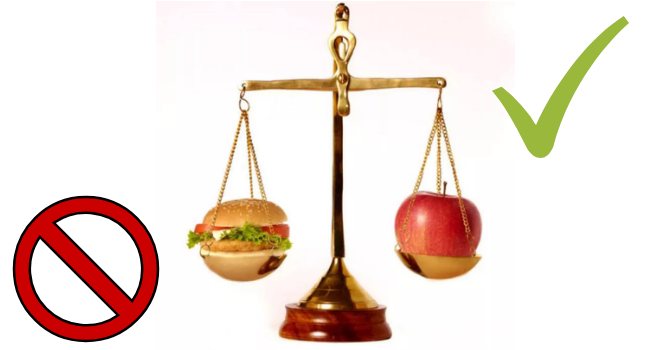
Important!
This diet for weight loss cannot be followed for a long time, since a 1200-calorie menu cannot be considered completely balanced. As fasting days when losing weight or during the Plato effect, you can safely stick to this menu for 1200 kcal once every 5-7 days. Additionally, it is recommended to take a multivitamin to avoid negative side effects from this 1200 calorie per day diet.
Do you think a 1200 kcal menu with BJU calculation is an effective nutrition system for weight loss? Let's discuss whether a menu of 1200 kcal per day with calculation of bju can be considered the basis of proper nutrition for weight loss?
If you liked the 1200 kcal menu with bju, then it’s easy to thank! I would be very grateful if you share this article on social networks.
PS Also, don’t forget to subscribe to our newsletter and you will be the first to receive your correct diet menu for weight loss.
Sincerely, Irina Lipatkina.
Spread the love
Calculation of calories and nutrition, planning a diet for weight loss and more
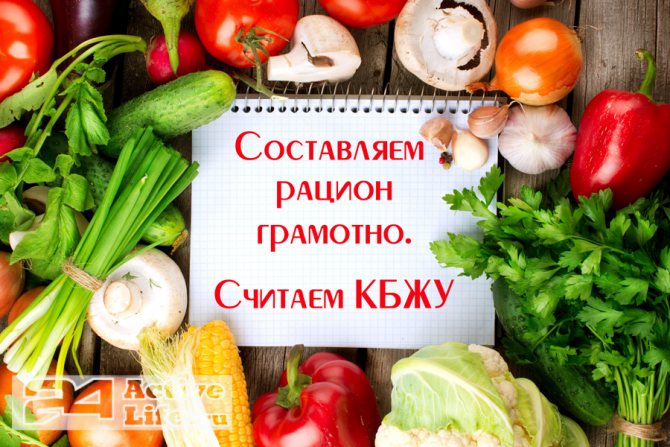
Hello, dears, today I want to share with you useful calculations of the diet and KBZHU .
A lot is said and written about this. But not everyone understands this. to talk and know about calorie and BJU (protein, fat, carbohydrate) of the diet . If you have ever thought about a healthy and beautiful body , then this information is definitely for you.
You and I must understand this issue once and for all in order to be literate and not fall into the hands of incompetent persons, of whom there are quite a few now. Don't make easy money off of your nutritional illiteracy . Moreover, the calculations are more than simple and accessible to everyone to master.
Why is it important to know not only the calorie content but also the BJU of the diet?
You've probably noticed that it's very easy to gain your daily calorie intake with unhealthy foods, much easier than with healthy fresh food . And I think you know that a standard fast food meal will likely meet your caloric needs or be close to it.
But here we will find out why not only calories are important , but also the nutritional . Even if fast food is your only meal of the day and you do not exceed your daily caloric , the properties of this diet will never allow you to create the body of your dreams .
What is the reason for this?
The reason is a nutrient imbalance . Fast food food contains critically little protein, virtually no complex carbohydrates, but, on the contrary, a lot of unhealthy fats Such products are inferior in composition and are not able to give the body energy for the whole day and provide good material for the construction of body tissue, primarily muscles. After all, they help us like no one else in the fight against extra pounds.
And here is what such products will give us:
- cellulite, - problems with skin, hair, nails, - fatigue, apathy, irritability, poor health in general.
That is, the body will lose weight up to a certain limit if it is given a calorie deficit, but at the same time you will look terrible and feel bad. This applies to diets and fasting and to any cuts in nutrients in the diet in favor of a calorie deficit.
What can you do to avoid disappointment when working on your figure?
It is important to follow simple rules for constructing a diet : monitor not only the calorie content , but also the quality of the products and the composition of the BJU .
Point by point, important points in building a competent diet:
1. Calorie content
calories according to the diagram shown in the picture (click on the picture - it enlarges):
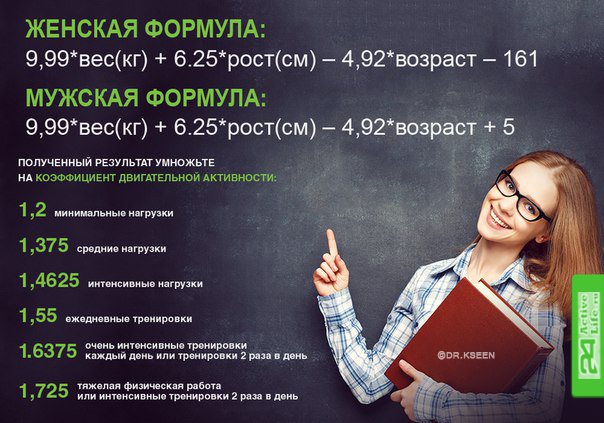
If you don’t want to do the math yourself, you can use this calculator .
There is also an option that I definitely use if I advise clients personally, i.e. not online, but in meetings, is to use a body weight bioanalyzer . In general, if possible, I advise you to buy such a car.
It will help you understand whether you are taking certain steps towards your dream figure correctly. In addition to calories , such scales measure biological age, bone strength, muscle mass, and the amount of fluid and fat in the body. These options are very helpful in monitoring your progress .
There are many more formulas that you can use too. You can look here Formulas for calories .
But, I would recommend sticking to the formulas from my picture or using an online calculator , as well as smart scales , which I just sang an ode to;)
There is also a good free phone app called Fatsecret , you can use it if you are comfortable with it.
You shouldn’t be very meticulous in your calculations; this is only necessary for performing athletes. Ordinary people who want to understand issues of proper nutrition and a healthy lifestyle need an initial minimum, a knowledge base. And this base will work.
And so, we definitely count calories. It is important. And let’s move on to the equally important, as you already understood, calculations of the BJU.
2. Calculation of BZHU and examples of products:
— Squirrels
Examples of products: meat, poultry, fish, seafood, eggs, dairy products, legumes (soybeans, lentils, mung beans, chickpeas, for example).
Calculation: 1.5-2 g multiplied by 1 kg of current body weight
— Fats
Examples of foods: oils, nuts, avocados, fatty fish (mackerel).
Calculation: 0.8-1.1 g multiplied by 1 kg of current body weight.
- Carbohydrates
Examples of sources of fast carbohydrates: fruits, dried fruits (I don’t write about unhealthy foods;), you know them yourself).
Examples of sources of complex carbohydrates: cereals, whole grains, wholemeal flour, vegetables and herbs, fruits with a GI of up to 60 (read about the GI - glycemic index here ).
Calculation: 2-3 g multiplied by 1 kg of current body weight (on weight maintenance, if you no longer need to lose weight, 4-5 g/kg , this is about 60-70% of the daily diet)
* We create a diet with a predominance of complex carbohydrates, do not forget about this.
**Depending on your progress, change your caloric intake. Every 5 kg lost requires recalculation of KBZHU. Try to increase your energy expenditure through physical activity. Maintain a calorie deficit of about 500 kcal/day for weight loss. And so that this deficit is 200-300 kcal due to incoming food, and 200-300 kcal due to physical activity.
General schemes for calculations are as in the pictures:
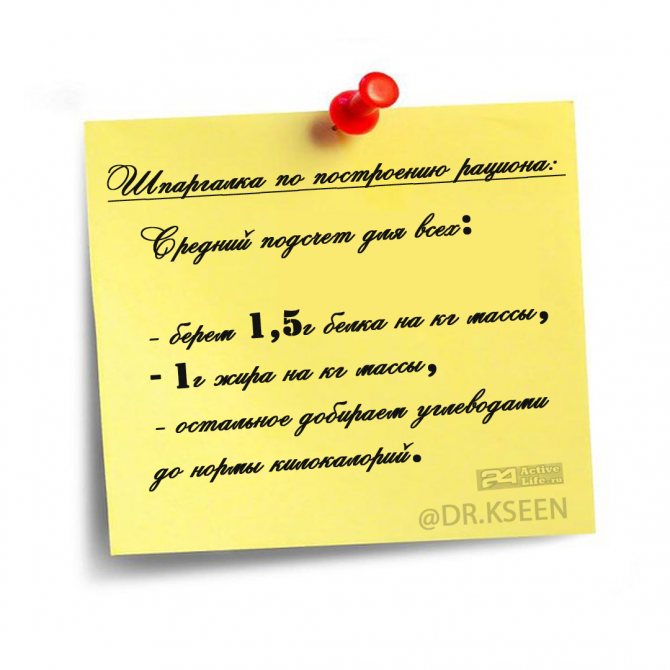
Don't forget about this diet distribution . You shouldn’t push yourself into strict limits, however, if you really need results, then try to act wisely.
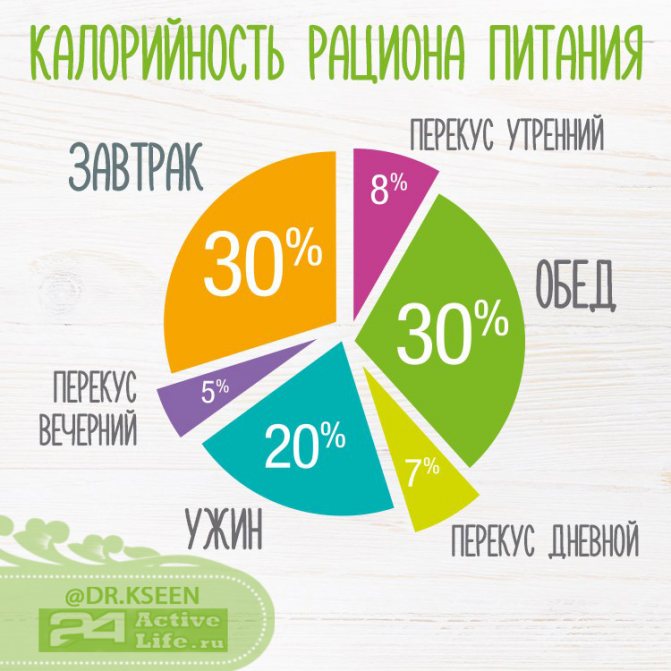
Try to calculate your daily requirement of BZHU and select healthy products from this plate in the picture:
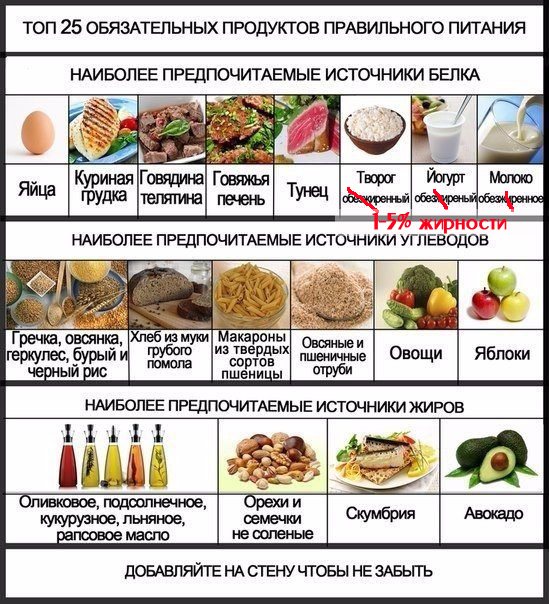
***Please note that I do not recommend using low-fat products, including cottage cheese. Such products are made by physical and chemical means, which results in the loss of healthy protein, and to add flavor to such products, manufacturers add carbohydrates. Thus, low-fat products not only lose their beneficial properties, but also acquire bad qualities.
As you can see, in order to lose weight wisely and without harm to your health , you don’t need to exhaust yourself with diets and hunger, and you also don’t need heavy physical activity. Using these simple rules to control KBJU , you will lose weight and control weight easily , and your well-being and health will be at a high level!
By the way, all the techniques and rules for competent weight loss and control are in my course “Say NO to diets!” Today there is a huge discount on the course! For questions about downloading (temporarily there is no download through the work page), please contact us by email or by phone in the Contacts section.
Did you like the article? Then please do the following:
- Give it a "like";
- Retweet;
- Share this article on social networks;
- And of course, leave your comment below.
